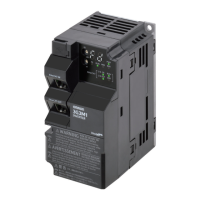Parameter No. Function name Data
Default
data
Unit
F06
1st Rated Voltage at Maximum
Output Frequency
80 to 240 V (200-V class)
160 to 500 V (400-V class)
Dependent
on capacity
V
A04
2nd Rated Voltage at Maximum
Output Frequency
*1
Dependent
on capacity
V
*1. To enable switching to the 1st and 2nd control, allocate “12: SET (2nd control)” to either of input terminal
[DI1] to [DI7].
0
Output voltage [V]
Output frequency [Hz]
Rated Voltage at Maximum
Output Frequency(F06/A04)
Rated Voltage at Base
Frequency (F05/A03)
Base Frequency
(F04/A02)
Maximum Output
Frequency (F03/A01)
Precautions for Correct Use
• For these motors, check the rated motor current and select an appropriate inverter based on
the rated current of the inverter.
• Do not set the base frequency to lower than the motor rated frequency. Doing so may cause
overload or motor burnout.
•
Do not select a motor incoming voltage higher than the motor rated voltage. Doing so may
cause an overload or motor burnout.
5-3-3
Motor Electronic Thermal Function
The motor electronic thermal function prevents the motor from overloading and burning. In addition,
M1 has a braking resistor electronic thermal function. (Refer to 5-12-2
Braking Resistor Electronic
Thermal Function on page 5-75.)
•
The motor electronic thermal function calculates the electronic thermal calculated value for motor
protection based on the output current of the inverter. The status of the electronic thermal function
can be checked by the monitor of electronic thermal overload protection for motor (monitor mode:
5_62). When 100% is reached in the percentage display, motor overload (alarm OL1 or OL2) is de-
tected.
• The motor electronic thermal function sets Motor Electronic Thermal Level (F11/A07) and Motor
Electronic Thermal Characteristic Selection (F10/A06), and Motor Electronic Thermal Time Constant
(F12/A08).
• When Motor Electronic Thermal Overload Protection Data Retention (H89) is set to 1, the electronic
thermal cumulative value and thermal cumulative value of the overload early warning are saved in
the EEPROM when an insufficient voltage state has occurred, and, when the power is next turned
ON, EEPROM saved values are used as the defaults for cumulative values.
5 Basic Settings
5-20
M1 Series Standard Type User's Manual (I669)

